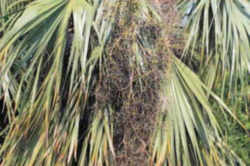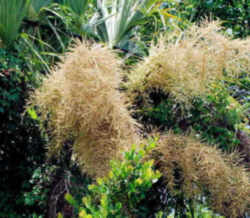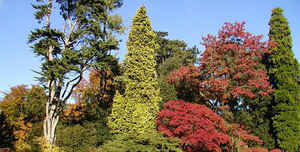
Florida Symbols
Florida State Tree
Sabal Palm (Cabbage Palmetto) 
(Arecaceae Sabal palmetto)
Adopted in 1953.
The 1953 Legislature designated the sabal palm, (Arecaceae Sabal palmetto,) as the Florida State Tree. This palm is the most widely distributed in the state and possesses a majesty that sets it apart from other trees. It grows in almost any soil and has many uses including food and medicine. It is also used widely for landscaping because of its universal popularity. In addition, the 1970 Florida Legislature mandated that the sabal palm should replace the cocoa palm on the Florida State Seal.
Florida State Tree: Sabal Palm (Cabbage Palmetto)

Cabbage palmetto, (Sabal palmetto,) is the most northerly and abundant of the native tree palms. Other names sometimes used are Carolina palmetto, common palmetto, palmetto, and cabbage-palm. This medium-sized unbranched evergreen palm commonly grows on sandy shores, along brackish marshes, in seacoast woodlands of Southeastern United States and throughout peninsular Florida. It can tolerate a broad range of soil conditions and is often planted as a street tree. Abundant fruit crops provide a good supply of food to many kinds of wildlife.
Identification of the Sabal Palm (Cabbage Palmetto)

- Leaf: Alternate, palmately compound, fan shaped; leaflets very long (4 to 6 feet) and lance shaped, leaf stalks are long, extend through the leaf, and are without sharp edges; green in color, overall leaf nearly round and several feet long.
- Flower: Small white flowers occurring on large (several feet), branched clusters, appearing in early summer.
- Fruit: Fleshy drupe, nearly round, 1/3 to 1/2 inch across, dark shiny blue, maturing in early fall and persistent into the winter.
- Twig: Absent, since leaves appear directly out of unbranched trunk.
- Bark: Gray brown, tough, splits vertically.
- Form: Tall (to 80 feet), straight trunk with a short rounded crown.
Florida Law
The law designating the sabal palmetto palm as the official Florida state tree is found in the Florida Statutes, Title 4, Chapter 15, Section 15.03.
TITLE IV - EXECUTIVE BRANCH Ch.14-24.
CHAPTER 15 - SECRETARY OF STATE.
SECTION 15.03.
15.031 State tree.--
(1) The sabal palmetto palm, which is also known as the cabbage palm, and sometimes as the cabbage palmetto, a tree native to Florida, is hereby designated
as the Florida state tree.
(2) Said state tree being now extensively used for commercial purposes, the provisions of this section shall not be construed to limit in any manner
said use thereof in business, industry, commerce, for food, or for any other commercial purposes.
History.--ss. 1, 2, ch. 28126, 1953.
Taxonomic Hierarchy: Sabal Palmetto Palm
Kingdom: Plantae - Plants
Subkingdom: Tracheobionta - Vascular plants
Superdivision: Spermatophyta - Seed plants
Division: Magnoliophyta - Flowering plants
Class: Liliopsida - Monocotyledons
Subclass: Arecidae
Order: Arecales
Family: Arecaceae ⁄ Palmae - Palm family
Genus: Sabal Adans. - palmetto
Species: Sabal palmetto (Walter) Lodd. ex Schult. & Schult. f. - cabbage palmetto







